As of yet it’s impossible to have your own Bulbasaur, but with leaves that look like tiny turtle shells, the String of Turtles offers us a beautiful consolation prize.
String of turtles is one of my favorite indoor plants, with its elegant trailing vines. It’s basically like having a plant and a bunch of very low-maintenance pets in one.
We’ll cover the wild colors that string of turtles leaf veins turn as they grow, when it’s getting too much sunlight, and how to take care of it. I’ll also discuss the best ways to propagate your plant and deal with the most common issues that come up.
Oh, and did I mention there’s an elusive variant? Stay tuned.
Table of Contents
String of Turtles Care Guide
History, habitat, and characteristics
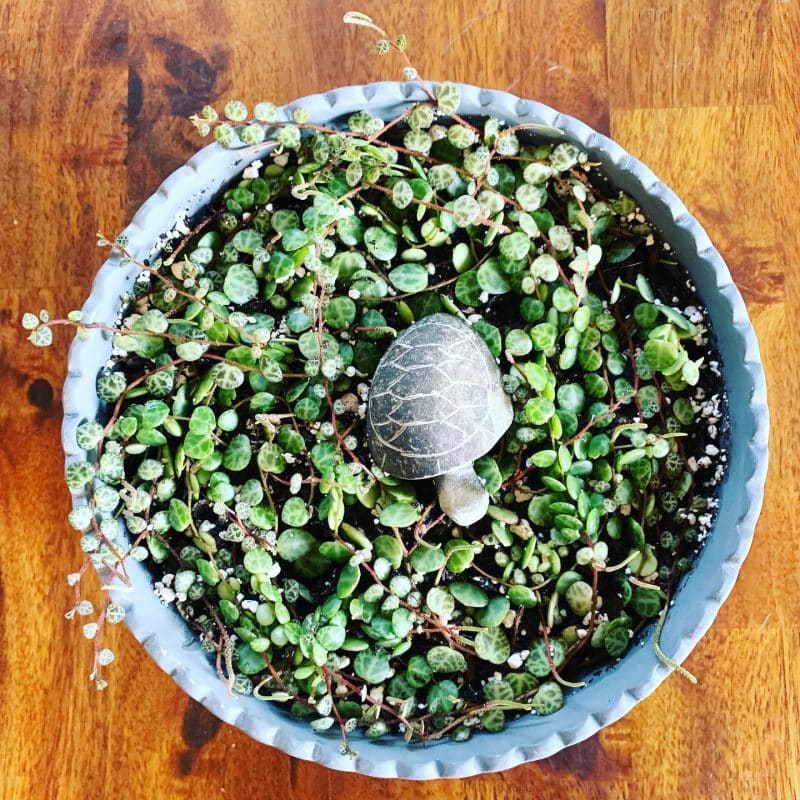
Native to the South American rainforests of Ecuador and Brazil, String of turtles is both an epiphyte, which means it grows on tree trunks, and a lithophyte, which means it creeps across rocks on forest floors. It also has an impressive collection of nicknames – people call it turtle vine, turtle string, chain of turtles, jade necklace, and radiator plant (you’ll find out why later on).
From the Piperaceae family and Peperomia genus, string of turtles even sparks debate about its real scientific name. It’s most often called Peperomia prostrata, but is officially a subspecies of rotundifolia (Latin for “having round leaves”) known as Peperomia rotundifolia var. pilosior (talk about tongue twisters). Although similar in name, string of turtles is horticulturally distinct from String of Hearts.
String of turtles is a trailing, vining plant with round, fleshy dark green leaves covered in white veins. It’s not hard to guess what these small leaves look like – turtle shells! Their veins turn colors as they mature, morphing from white to dark blue, silver, and finally purple. Fun fact: this plant also purifies the air.
String of turtles can grow up to five inches tall before beginning to vine downward anywhere from 1-3 feet. The wider its pot is, the wider its spread will be. These guys grow slowly as young plants, achieving their maximum height in 3 to 5 years.
String of turtles flower in creamy green and red spikes that look like rat tails and bloom all year long, but this plant is mostly known for its foliage. Many people pinch off its flowers, or inflorescences, so the plant has more energy to grow its prized vines. You can keep the flowers if you like, but cut them off after they’re done blooming to redirect your plant’s energy to its foliage.
Despite the sheer number of Peperomia plants that exist, estimated at over 1,000 species (not to mention the hybrids and cultivars), there is only one known variation of the Peperomia prostrata plant, the elusive Magic Marmer. Variegation occurs on adult plants due to a rare natural mutation, which produces tiny white or pink leaf spots.
The only difference in care for a variegated string of turtles is light levels. It will need more light than a traditional turtle string to maintain its colorful spots. That being said, it appears there are no official cultivars so far, though, so if you come across a nursery selling a stable line, let us know in the comments!
The string of turtles isn’t difficult to take care of at all. Let’s find out the ideal light, water, temperature, and soil conditions for it next.
Light
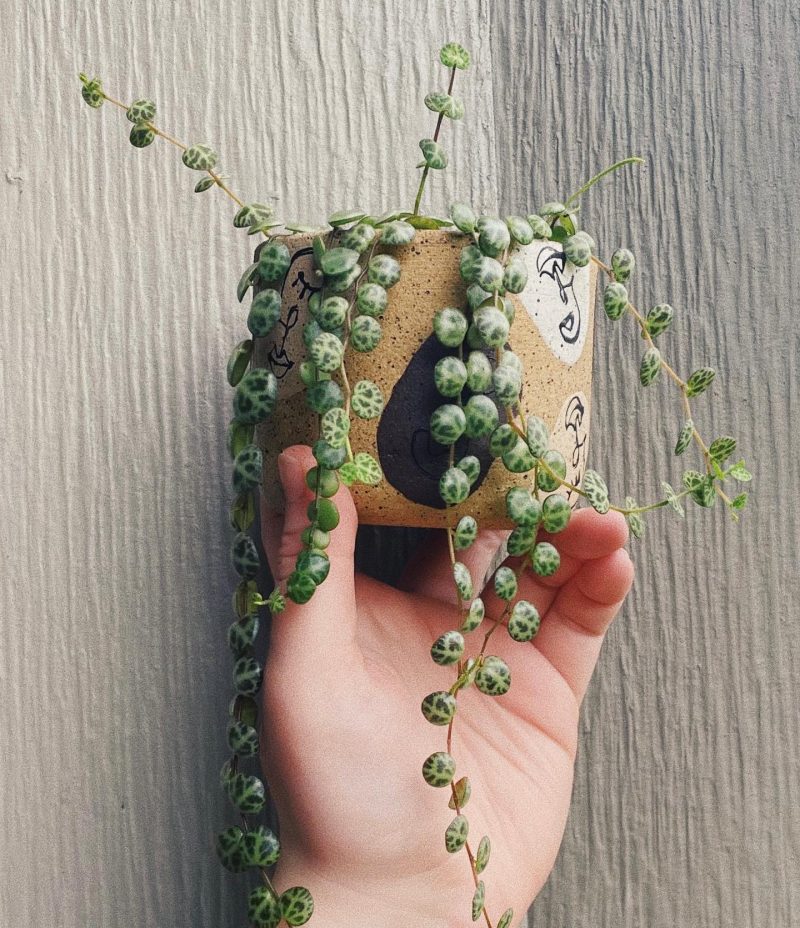
String of turtles needs bright indirect light, ideally from an east or west-facing window. This mimics the dappled light it receives in its natural rainforest environment under higher tree canopies. Don’t keep it in direct light or you risk burning its eponymous leaves.
Our suggestion: place your string of turtles on a high shelf so its trailing vines can have free reign. Turtles plants need even light to maintain uniform fullness and color from top to bottom, though, so consider putting them on the second highest shelf so their topsoil gets as much light as their gorgeous leaves.
The amount of light this Peperomia plant gets changes the color of its leaves. If your string of turtles leaves don’t seem to have enough variegation, it needs more light. This is because any part of the leaf that isn’t green has less chlorophyll, which helps it grow. A plant that isn’t getting enough bright indirect sunlight will grow totally green leaves to increase its store of chlorophyll.
If you notice its leaves are completely green, move the turtles plant closer to your window, making sure to avoid direct sun. You can also consider using an artificial grow light or LED grow light, but make sure its leaves don’t scorch.
Water
While they may resemble the succulent leaves of other plants, string of turtles crave more water than the average succulent. As a semi-succulent species, it stores water in its leaves, but has a shallow root system. This plant’s leaves can easily turn mushy if overwatered.
Okay, but how often should you water a string of turtles? Well, that depends on the light and temperature conditions in its environment. Typically, this plant needs a thorough watering every 2 to 3 weeks in the growing season, but the frequency may increase if it’s in a brighter, hotter setting. If the top two to three inches of soil is dry to the touch, it’s time to water.
Don’t be scared to pour enough to get the soil thoroughly moist. Make sure water is dripping out the pot’s drainage holes. If this plant is in the right light and temperature conditions and has properly aerated soil, which we’ll get to in a bit, thoroughly watering it should be a refreshing drink and not a root-drowning dunk.
If you’re nervous about overwatering, consider bottom-watering this plant instead. This is easy to do – just fill a bowl with water and place 1/4th of the pot into it for 10 minutes. This way, the roots can drink up exactly the amount of water they require while avoiding root rot. Distilled water works better than tap for most houseplants.
Temperature and humidity
Like most tropical plants and actual turtles, this plant hates the cold. String of turtles thrives in USDA Zone 10-12, with warm temperatures between 65-85 degrees Fahrenheit, like the drafts coming from a radiator (hence the “radiator plant” nickname). It can survive in average household temps, but anything below 55 degrees Fahrenheit can cause leaves to wither and drop (and you to shiver).
High humidity of 40-60% is the way to go with the string of turtles. You need to achieve a delicate balance of high humidity and moist soil without drowning its shallow roots. But don’t worry – there are a handful of tried and true ways to increase the humidity in its environment, including:
- Placing it on top of a tray with pebbles and water
- Setting it near a humidifier
- Misting it every few days
- Grouping it with other plants so they can share humidity in a process known as transpiration
Soil and planting
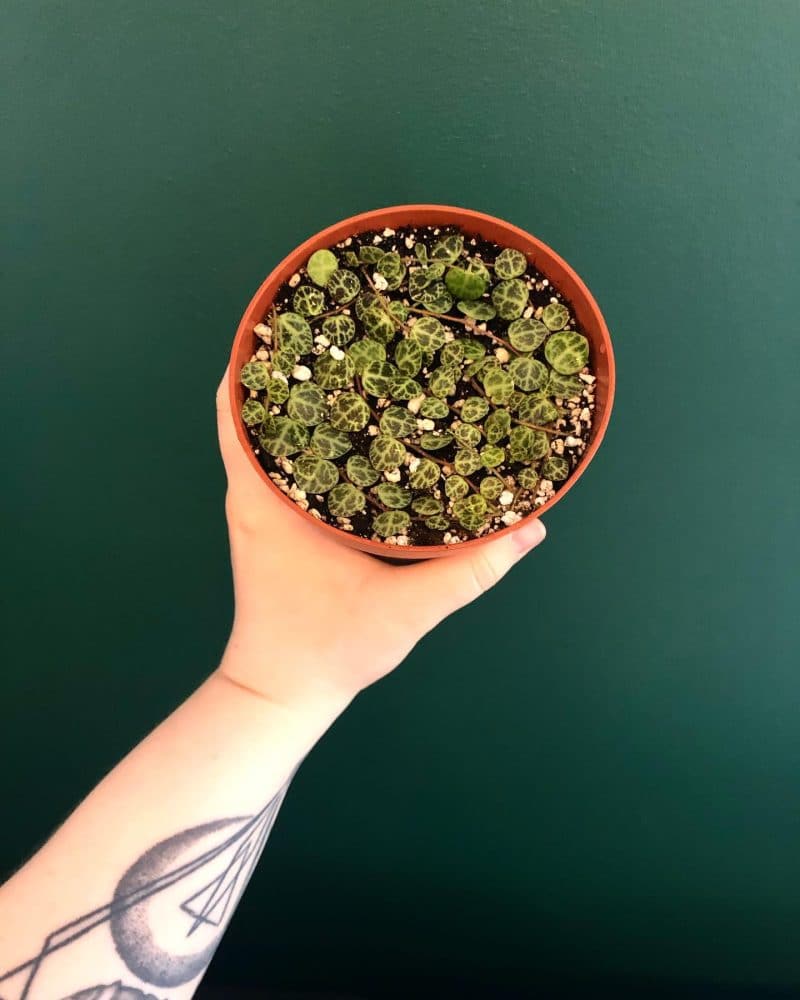
Because it has such a small root system, string of turtles needs well-draining soil so its roots can breathe. I recommend:
- 50% peat-based potting mix
- 25% perlite
- 25% sand
If you don’t have this exact mix, don’t worry – as long as you have a soil mixture that drains enough to avoid root rot, your plant should be just fine. Another example would be predominantly cactus or succulent potting mix with horticultural pumice, for instance.
The string of turtles plant likes to be a bit rootbound and has a slow growth rate, so you won’t have to repot it for 2-3 years, and it won’t need larger than a 6″ pot for a very long time. Add a layer of fresh fertile potting soil to the top of the pot annually.
When you do repot string of turtles, make sure to choose a pot size that’s only 1 or 2 inches wider than its current version so it has less soggy soil to sit in while its roots grow to fill the new volume. Also consider using a terra cotta pot, since they dry out more quickly than other types and help prevent root rot. A potting mix moist but not drenched is ideal here.
Pruning
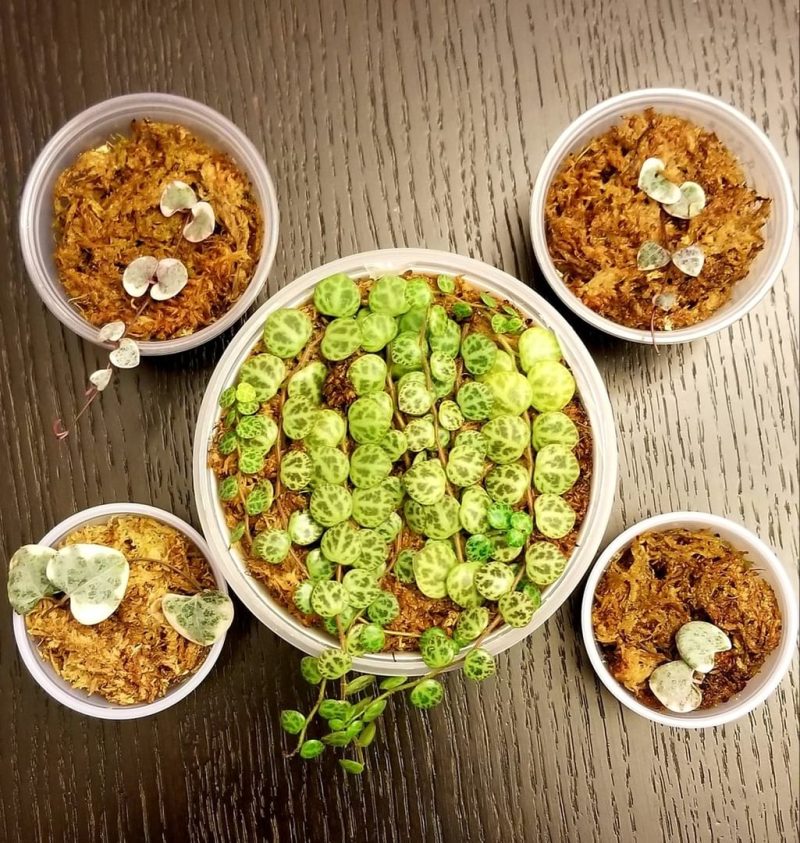
You can cut off dead foliage to encourage new growth in a string of turtles plant that’s struggling. Don’t prune more than 1/3 of this plant at a time or you’ll risk stunting its growth and losing the bushiness its vines are known for.
String of turtles are small indoor plants, but they tend to grow wider than tall, so if you want to discourage growth, pinch their stems. Remember to save any cuttings for propagation, which we’ll discuss later.
Fertilizer
During spring, add a slow-release succulent fertilizer diluted with 50% water twice a month. This helps the leaves keep their unique variegation and pattern.
During summer, apply fertilizer one a month. Don’t use it at all during fall and winter. It’s important not to use too much fertilizer since this can burn the plant.
Propagation guide
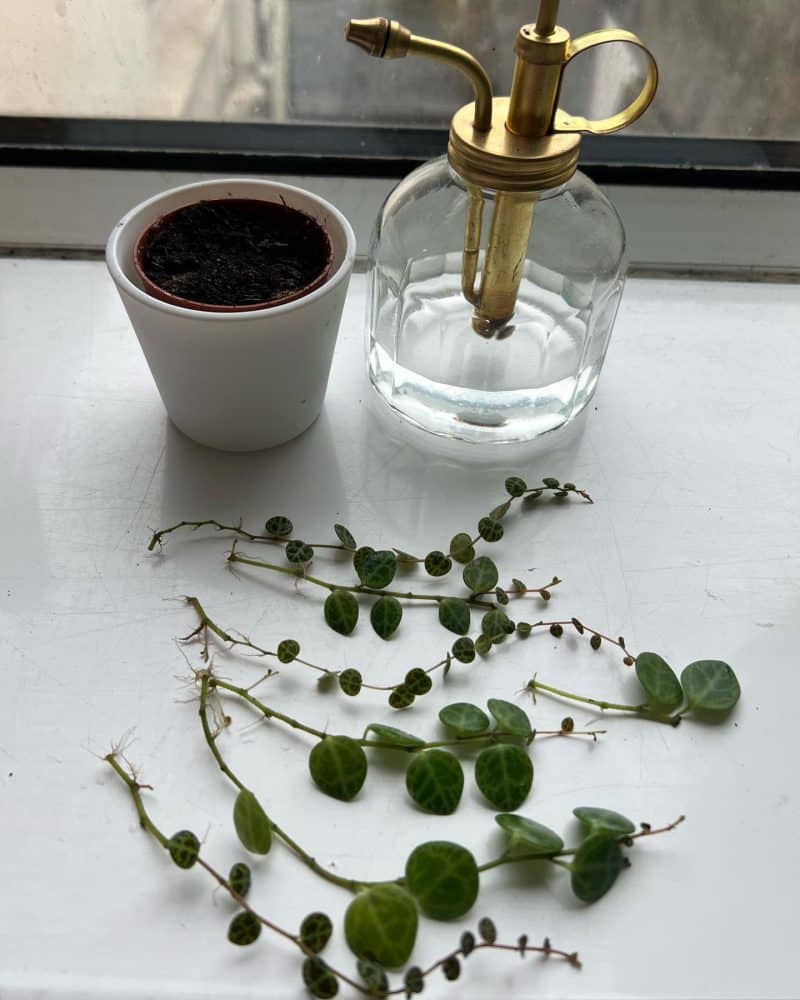
The best time to propagate your string of turtles is in spring and summer during the active growth period. As with other vining plants, you have your choice of several methods:
- Sphagnum moss propagation. My recommended method. Choose it if you want to increase the fullness and growth speed of your plant, since it allows stem nodes to be in contact with air and water at the same time, effectively supercharging root growth conditions. It’s slightly more involved than the other two methods, but not by much.
- Soil propagation. Choose it if you have experience with soil propagation and want a familiar method.
- Water propagation. Like soil, pick it if you want to use a familiar technique. Roots may take a little longer to grow than with soil prop, but it’s fun to watch their progress. The only added step compared to soil propagation is repotting at the end.
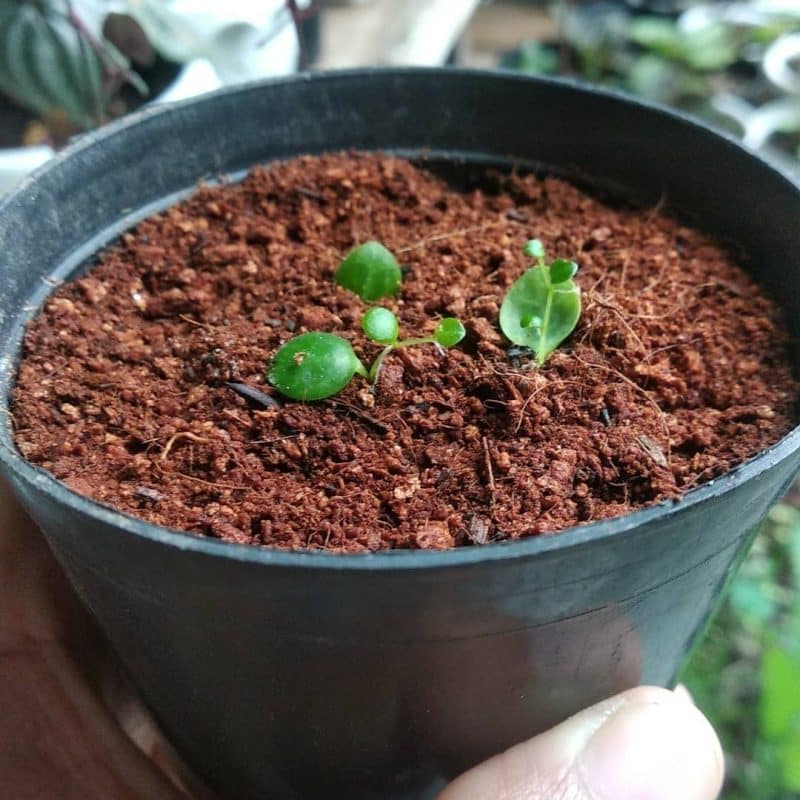
To propagate your string of turtles in sphagnum moss:
- Cut at least a three-inch long section of vine with a few leaves at the node, or where the leaves sprout, leaving a one-fourth inch of vine at each end. Cut as many as you’d like. (This is an excellent video showing a step-by-step breakdown of the sphagnum moss method).
- Soak a generous bunch of sphagnum moss in warm water for five minutes, then squeeze the water out so it’s moist without being overly wet.
- Make a clear plastic container, like a takeout box or Tupperware, into a propagation box by layering in a thick bunch of moist sphagnum moss.
- Place the leaf cuttings on top of the moss face up so their nodes are making contact.
- Loosely cover the container with clear plastic wrap to retain humidity, propping it up (with chopsticks, for instance) so it doesn’t touch the cuttings. Remove the wrap every few days for several hours to increase airflow.
- Keep the box in a bright, warm area. Roots will form in a few weeks.
- When roots are at least two to three inches long, plant the newly sprouted cuttings in a soil mix that drains well. If some of the moss remains on the cuttings, that’s fine, since it helps aerate the soil.
To propagate your string of turtles in soil:
- Cut off two inches pieces of a vine from the mother plant with scissors or shears (this is the familiar part!).
- Remove the bottom leaves so only the bare vine is placed into the soil. Do this carefully, because this plant has fragile stems that break easily.
- It’s optional to dip the vine cuttings in rooting hormone to encourage root growth. Cover the bottom vine nodes with well-draining soil in a warm area with bright light.Pro tip: To increase humidity in a drier area, keep the cuttings under a clear dome or plastic bag, making sure to prop it up so it doesn’t touch the plant or soil surface, until their root system is established.
- Water it once a week, keeping the soil moist but not sopping. Roots should start growing after several days.
To propagate your string of turtles in water:
- Cut off two inches sections of a vine with sharp scissors or shears.
- Remove the bottom leaves (carefully!) so only the bare vine is placed into the water.
- Put the stem cuttings in a glass of water and place it in a warm, bright location with indirect sun.
- Repot a propagating string after its roots are 2-3 inches long. This can take anywhere from several weeks in spring and summer to several months in fall and winter.
Next, I’ll discuss what to do when your plant has bumpy leaves, tiny white flying bugs, and more.
Common issues
String of turtles are easy to care for, but it’s good to know the warning signs of a problem so you can take action early. Most issues are caused by a light or water imbalance.
Bumpy leaves. Raised, scabby bumps on leaves, also called edema, means the soil is too wet and the plant is overwatered. Stop watering it and only start again when the soil is dry two to three inches down.
Rotted stems. You’re overwatering the plant or its soil isn’t draining well enough, so its roots are paying the price. Use a cactus or succulent soil with peat, perlite, or sand to keep the soil from retaining excess moisture. Let the top fourth of the soil dry out between waterings.
Faded pattern or color. Older string of turtles leaves naturally fade, but if you notice this happening to younger leaves, your plant could need more fertilization.
Shriveled vine ends. Shriveled, dry vines mean the plant needs less direct sunlight and/or more water. Water it either more frequently or more thoroughly each time so that the pot’s drainage holes are dripping.
Dropping leaves. Plant leaves dropping is due to temperatures that are too cold, or a water level that’s off – either too much or too little. If your plant is in a warm environment and its soil is dry, you need to water it more; wet, and you need to water it less.
Red leaves. The plant is getting too much direct harsh sunlight. Move it farther away from a window or hang a light fabric over the window to diffuse light, or limit sun exposure to an hour a day. Remove any red or yellow leaves to encourage new plant growth.
Diseases and pests
Healthy plants don’t usually suffer from diseases and common pests, but if you do have an infected plant or one with a bug infestation, it’s not hard to come to its rescue.
Root rot. This can occur when an indoor plant is overwatered or has soil that’s too dense. You’ll be able to tell when your plant’s roots are rotting because they’ll be wet and slimy. Repot them in a mix that breathes well in a pot with large enough drainage holes.
Spider mites, mealybugs, aphids, thrips, whiteflies. Spraying soapy water is a great way to get rid of bugs if your plant isn’t healthy enough to avoid spider mites and attacks from other insects. If soapy water doesn’t get rid of the pests, use neem oil diluted with 50% water and spray your string of turtles every week, getting its stem and the undersides of its leaves, until you don’t see them anymore.
Keep in mind that small bugs eat tiny holes out of your plant and lay eggs in them. The adults have wings, so they can also land on other indoor plants nearby. Even if you think you’ve eradicated all the adult insects, keep spraying the buggy plant and the ones around it for another week to prevent any larvae from hatching.
Conclusion

String of turtles starts out as a small plant that takes its time growing delicate trailing vines. With enough bright indirect light, high humidity between 40% and 60%, and temperatures on the warmer side, this plant will flourish.
Its turtle shell-like leaf veins turn an array of arresting colors as it matures, and it looks superb hanging down from tall places.
Propagate this beauty for friends in sphagnum moss (for speedy growth), soil, or water, or make more string of turtles plants just for yourself. I wouldn’t blame you.
If this article was helpful to you, feel free to share it with a friend so they can grow their own string of turtles. If you have any suggestions or questions, feel free to get in touch on Instagram or Twitter!
FAQ
-
Should you mist string of turtles?
Feel free to mist string of turtles every few days to increase the humidity in its environment, especially in the winter months. Do this less or not at all in the spring and summer, since this semi-succulent plant stores water in its leaves and should be able to get what it needs from watering. Just make sure the soil remains moist but not sopping at all times.
-
Is string of turtles rare?
String of turtles used to be more rare, but now you can find it pretty easily in most garden centers or nurseries.
-
Is Peperomia a string of turtles?
Strike that and reverse it – String of turtles is actually one of over 1,000 types of Peperomia! Peperomia are from the Piperaceae, or pepper, family.
-
Is string of turtles (Peperomia prostrata) a succulent?
It looks and acts like other succulents, but string of turtles is actually considered a semi-succulent. It stores water in its leaves but craves more water than and doesn’t like the dry environments of the average succulent.
-
Why is my string of turtles flowering?
Turtle strings flower at any time of year as part of their natural growth process. You can leave the flower buds alone or pluck them off to direct more energy to the plant’s vines.
-
Can you water string plants less than other plants?
A good rule of thumb is that String of Turtles plants need to be watered thoroughly when their soil is dry two inches down. For ideal turtles care, this means once every one, two, or even three weeks, depending on environmental conditions like light and temperature.


